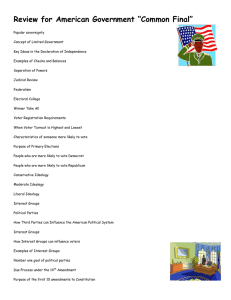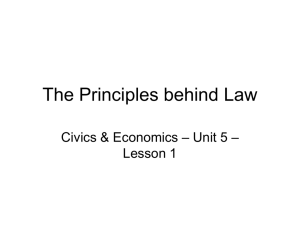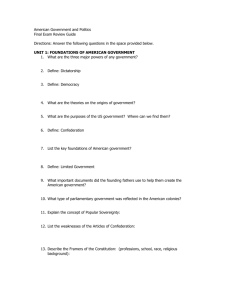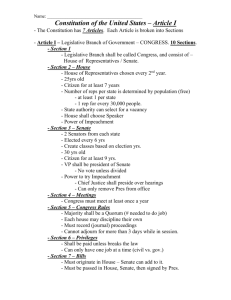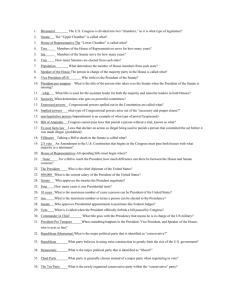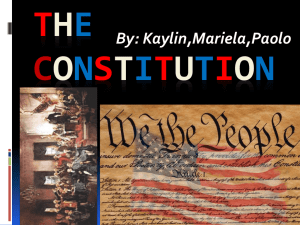American Studies First Semester Test 2012 Answer Key for Study
advertisement
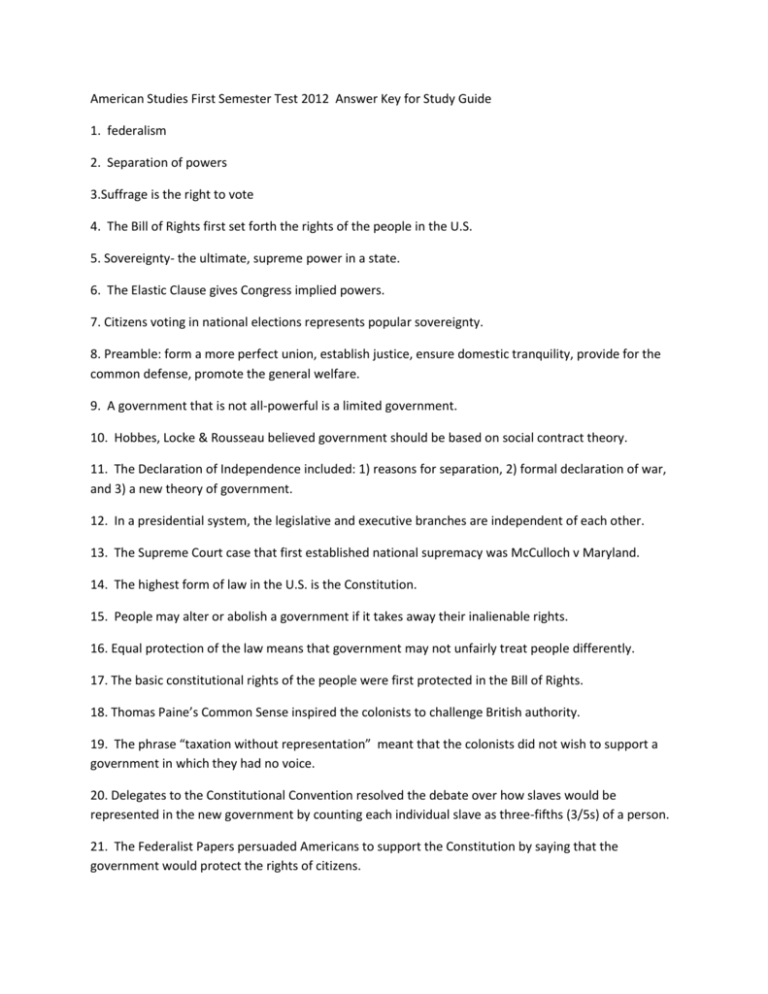
American Studies First Semester Test 2012 Answer Key for Study Guide 1. federalism 2. Separation of powers 3.Suffrage is the right to vote 4. The Bill of Rights first set forth the rights of the people in the U.S. 5. Sovereignty- the ultimate, supreme power in a state. 6. The Elastic Clause gives Congress implied powers. 7. Citizens voting in national elections represents popular sovereignty. 8. Preamble: form a more perfect union, establish justice, ensure domestic tranquility, provide for the common defense, promote the general welfare. 9. A government that is not all-powerful is a limited government. 10. Hobbes, Locke & Rousseau believed government should be based on social contract theory. 11. The Declaration of Independence included: 1) reasons for separation, 2) formal declaration of war, and 3) a new theory of government. 12. In a presidential system, the legislative and executive branches are independent of each other. 13. The Supreme Court case that first established national supremacy was McCulloch v Maryland. 14. The highest form of law in the U.S. is the Constitution. 15. People may alter or abolish a government if it takes away their inalienable rights. 16. Equal protection of the law means that government may not unfairly treat people differently. 17. The basic constitutional rights of the people were first protected in the Bill of Rights. 18. Thomas Paine’s Common Sense inspired the colonists to challenge British authority. 19. The phrase “taxation without representation” meant that the colonists did not wish to support a government in which they had no voice. 20. Delegates to the Constitutional Convention resolved the debate over how slaves would be represented in the new government by counting each individual slave as three-fifths (3/5s) of a person. 21. The Federalist Papers persuaded Americans to support the Constitution by saying that the government would protect the rights of citizens. 22. The theory of Divine Right as the origin of a state can be represented by a crown. 23. A person may do as he/she pleases in this country as long as he/she does not interfere with the rights of others. 24. Under the Full Faith and Credit Clause, a states’ official records must be recognized by every state in the Union. 25. The 13, 14, and 15th amendments are commonly called the “Civil War Amendments”. 26. The only amendment to be repealed dealt with prohibition (making alcohol sales illegal). 27. Before the adoption of the 17th amendment, state legislators chose senators. 28. The 15th, 19th, and 26th amendments all deal with the right to vote. 29. 2/3s of both houses of Congress and ¾’s of state legislatures must approve a formal amendment. 30. The formal amendment process represents the principal of federalism. 31. The informal amendment process results from the daily experience of government. 32. A common power reserved to the states is to establish schools. 33. Additions to the Constitution are called amendments. There are 27 of them currently. 34. The most typical process of amending the Constitution involves proposals at the national level and ratification at the state level. 35. Three expressed powers of Congress are calling a declaring war, calling a national militia, and governing the District of Columbia. 36. The primary role of Congress is to write and enact laws. 37. One important aspect of the first amendment’s freedom of assembly is the right to engage in peaceful associations. 38. writ of habeas corpus 39. The 14th amendment was written to guarantee equal protection of the law for blacks , former slaves. 40. Under the 6th amendment, a person accused of a crime has the right to a speedy trial by jury. 41. The 9th amendment provides that the people have other rights besides those listed in the Constitution. 42. The U.S. Congress has two houses, so it is called a bicameral system. The two houses are the Senate and the House of Representatives. 43. Congress has a total of 535 members in both houses combined. 44. A U.S. citizen may vote at age 18. 45. The presiding officer in the House of Representatives is called the Speaker of the House. 46. The President of the Senate is the same as the Vice President of the United States. 47. Measures brought before Congress to be made into laws are called bills. 48. In the Senate, attempts to delay a vote on a bill by “talking it to death” is called a filibuster. 49. More than 90% of bills that do not become law die in committee. 50. Under the Constitution, all bills for national taxes or government spending must begin in the House of Representatives. 51. A cloture stops a filibuster because it sets a time limit on debate. 52.Conference Committees are temporary groups that attempt to achieve a compromise between Senate and House versions of a bill. 53. When the President is absent, the formal head of the Senate is the President Pro Tempore. 54. All treaties must be approved by a 2/3s vote of the Senate. 55. Concurrent powers are powers shared by the federal and state governments. 56. A U.S. Census is taken every ten years. 57. Reapportionment is the process by which congressional districts are redrawn based on shifts of states’ populations. 58. Congress may override a presidential veto by a 2/3s vote in both houses. 59. Members of the House differ from members of the Senate in number, terms, and required qualifications. 60. Interest groups, citizens, the president and others are allowed to suggest ideas for a bill.
